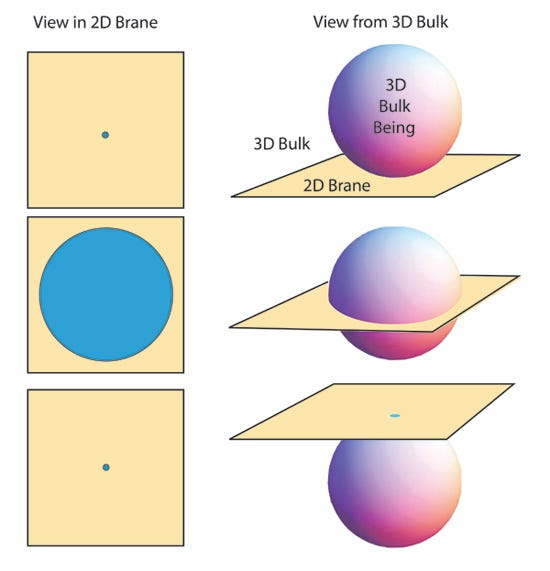
An ‘Interstellar’ Explainer: What Are Bulk Beings?
Nobel Prize-winning physicist Kip Thorne was the science consultant and executive producer to Christopher Nolan’s science fiction epic Interstellar. The following explanation of bulk beings, a concept critical to the film’s plot, is an excerpt from Thorne’s New York Times bestselling book, The Science of Interstellar.
All the characters in Interstellar are convinced that bulk beings exist, though they use that name only rarely. Usually, the characters call the bulk beings “They.” A reverential They. Early in the movie, Amelia Brand (played by Anne Hathaway) says to widowed astronaut Cooper (Matthew McConaughey), “And whoever They are, They appear to be looking out for us. That wormhole lets us travel to other stars. It came along right as we needed it.”
One of Christopher Nolan’s clever and intriguing ideas is to imagine that They are actually our descendants: humans who, in the far future, evolve to acquire an additional space dimension and live in the bulk. Late in the movie, Cooper says to TARS (a robot voiced by Bill Irwin), “Don’t you get it yet, TARS? They aren’t beings. They’re us, trying to help, just like I tried to help Murph.” TARS responds, “People didn’t build this tesseract” (in which Cooper is riding). “Not yet,” Cooper says, “but one day. Not you and me but people, people who’ve evolved beyond the four dimensions we know.”
2D Brane and 3D Bulk

In 1844 Edwin Abbott wrote a satirical novella titled Flatland: A Romance of Many Dimensions. Though its satire on Victorian culture seems quaint today and its attitude toward women outrageous, the novella’s venue is highly relevant to Interstellar. I recommend it to you.
It describes the adventures of a square-shaped being who lives in a two-dimensional universe called Flatland. The square visits a one-dimensional universe called Lineland, a zero-dimensional universe called Pointland, and most amazing of all to him, a three-dimensional universe called Spaceland. And, while living in Flatland, he is visited by a spherical being from Spaceland.
In my first meeting with Christopher Nolan, we were both delighted to find the other had read Abbott’s novella and loved it.
In the spirit of Abbott’s novella, imagine that you are a two-dimensional being, like the square, who lives in a two-dimensional universe like Flatland. Your universe could be a tabletop, or a flat sheet of paper, or a rubber membrane. In the spirit of modern physics, I refer to it as a two-dimensional (2D) brane.
Being well educated, you suppose there is a 3D bulk, in which your brane is embedded, but you’re not certain. Imagine your excitement when one day you are visited by a sphere from the 3D bulk. A “bulk being,” you might call him.
At first you don’t realize it’s a bulk being, but after much observation and thought, you see no other explanation. What you observe is this: Suddenly, with no warning and no apparent source, a blue point appears in your brane (top left of figure below). It expands to become a blue circle that grows to a maximum diameter (middle left), and then gradually shrinks to a point (bottom left) and disappears completely.

You believe in conservation of matter. No object can ever be created from nothing, yet this object was. The only explanation you can find is shown in the right half of the figure above. A three-dimensional bulk being — a sphere — passed through your brane. As it passed through, you saw in your brane its changing two-dimensional cross section. The cross section began with a point at the sphere’s south pole (top right). It expanded to a maximal circle, the sphere’s equatorial plane (middle right). It then shrank to a point, the sphere’s north pole, and disappeared (bottom right).
Imagine what would happen if a 3D human being, living in the 3D bulk, passed through your 2D brane. What would you see?
Bulk Beings From the Fifth Dimension, Passing Through Our 3D Brane
Suppose that our universe, with its three space and one time dimensions, really does live in a five-dimensional bulk (four space and one time). And suppose there are “hyperspherical beings” who live in the bulk. Such a being would have a center and a surface. Its surface would consist of all points, in four space dimensions, that are some fixed distance from the center, for example, 30 centimeters. The bulk being’s surface would have three dimensions and its interior would have four.

Suppose that this hyperspherical bulk being, traveling in the bulk’s out direction or back direction, were to pass through our brane. What would we see? The obvious guess is correct. We would see spherical cross sections of the hypersphere (see figure at left).
A point would appear from nothing (1). It would expand to become a three-dimensional sphere (2). The sphere would expand to a maximum diameter (3), then contract (4), shrink to a point (5), and disappear.
Can you guess what we would see if a four-dimensional human being living in the bulk were to pass through our brane? To speculate about this, you need to imagine what a four-dimensional human being — with two legs, a torso, two arms, and a head — must “look like” in the bulk, with its four space dimensions. And what its cross sections must look like.
The Nature of Bulk Beings, and Their Gravity
If there are bulk beings, what are they made of? Certainly not atom-based matter like us. Atoms have three space dimensions. They can only exist in three space dimensions, not four. And this is true of sub-atomic particles as well. And it is true also of electric fields and magnetic fields and the forces that hold atomic nuclei together.
Some of the world’s most brilliant physicists have struggled to understand how matter and fields and forces behave if our universe really is a brane in a higher-dimensional bulk. Those struggles have pointed rather firmly to the conclusion that all the particles and all the forces and all the fields known to humans are confined to our brane, with one exception: gravity, and the warping of spacetime associated with gravity.
There might be other kinds of matter and fields and forces that have four space dimensions and reside in the bulk. But if there are, we are ignorant of their nature. We can speculate. Physicists do speculate. But we have no observational or experimental evidence to guide our speculations. In Interstellar, on Professor Brand’s blackboard, we see him speculating.
It’s a reasonable, half-educated guess that, if bulk forces and fields and particles do exist, we will never be able to feel them or see them. When a bulk being passes through our brane, we will not see the stuff of which the being is made. The being’s cross sections will be transparent.
On the other hand, we will feel and see the being’s gravity and its warping of space and time. For example, if a hyperspherical bulk being appears in my stomach and has a strong enough gravitational pull, my stomach may begin to cramp as my muscles tighten, trying to resist getting sucked to the center of the being’s spherical cross section.

If the bulk being’s cross section appears and then disappears in front of a checkerboard of paint swatches, its space warp might lens the swatches, bending the image I see, as in the top half of this figure.
And if the bulk being is spinning, it might drag space into a whirling motion that I can feel and see, as in the bottom of this figure.
Cooper, Brand, and the crew of the Endurance never actually feel or see our bulk descendants’ gravity or their space warps and whirls. That, if it ever occurs, is left for a sequel to Interstellar. But older Cooper himself, riding through the bulk in the closing tesseract, reaches out to the Endurance’s crew and his younger self, reaches out through the bulk, reaches out gravitationally. Brand feels and sees his presence, and thinks he is They.
Kip Thorne’s ‘The Science of Interstellar’ is available wherever books are sold:
Amazon | Barnes & Noble | iBookstore | Indiebound | Powell’s

Subscribe to our monthly email to hear about Norton’s newest books.
